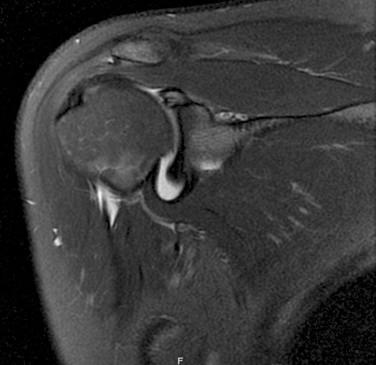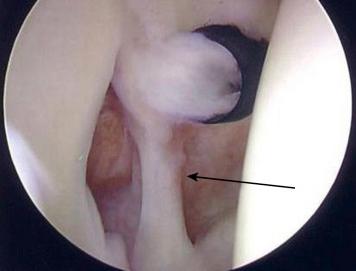Physical Address
304 North Cardinal St.
Dorchester Center, MA 02124
The treatment of lesions of the superior labrum has advanced considerably over the past two decades of shoulder arthroscopy, as has understanding of this complex structure. A rarely recognized source of shoulder pain in the latter part of the 20th century has now become one of the largest indications for shoulder surgery in board-certified candidates. Although less common than superior labrum anterior and posterior (SLAP) types I and II tears, type III (bucket handle tear of the superior labrum), type IV (extension of the tear into the biceps tendon), and type V (type II lesion with an associated Bankart lesion) SLAP lesions of the shoulder have been associated with higher-demand occupations and recurrent glenohumeral instability. This chapter outlines the clinical history, examination, and radiographic findings of patients presenting with types III, IV, and V SLAP lesions of the shoulder, as well as details the arthroscopic methods of current treatment.
Arthroscopic management of patients presenting with SLAP types III, IV, and V tears centers primarily on the treatment of the biceps tendon and debridement of the superior labrum in type III tears, treatment of the superior labrum and biceps tendon in type IV tears, and the combined treatment of the Bankart and type II SLAP lesion in type V tears. Treatment of type III tears consists primarily of debridement of the bucket handle tear of the superior labrum, with or without biceps tendon debridement or tenodesis of the long head of the biceps if the tear extends into the biceps tendon proper (a type IV tear). Patients with type V tears typically undergo arthroscopic pan-labral repair of the superior and anterior inferior labrum; however, in patients over the age of 35, there may be an indication for biceps tenodesis for treatment of the type II lesion.
Patients typically report activity-related pain in the shoulder.
Pain is characteristically described as deep-seated or “in the joint.”
The pain is primarily anterior and may limit athletic activities.
A remote or current history of shoulder dislocation may be present (type V tears).
Patients may report “clicking,” “clunking,” or mechanical symptoms.
Loss of velocity in throwing athletes or the feeling that the arm is going dead or numb may occur in a select number of patients.
The pain may be sharp or burning.
Patients with associated rotator cuff pathology may have overhead pain or nighttime symptoms.
Patients may report loss of range of motion or strength.
Both shoulders should be examined simultaneously.
Assess for atrophy or cutaneous lesions.
Palpate the anterior capsule, greater tuberosity, posterior capsule, acromioclavicular joint, bicipital groove, and coracoid process; document tenderness in any of these locations.
Range of motion (both active and passive) while standing and supine (to control scapular rotation) should be assessed.
Evaluate for elevation, abduction, and rotation (both internal and external), and document asymmetries.
If range of motion is painful, it should be documented.
Scapular rhythm should be evaluated during range of motion.
Rotator cuff strength testing should be evaluated fully:
External rotation at the side (infraspinatus/teres minor).
Empty can or full can test (supraspinatus).
Belly press, lift-off, or bear hug test (subscapularis).
Provocative testing maneuvers.
O’Brien test and Mayo dynamic shear testing to evaluate for SLAP tear.
Apprehension sign/Jobe relocation test to evaluate for instability and SLAP pathology.
Speed/Yergason test to evaluate for biceps tendon pain or subluxation.
Load and shift testing to evaluate for pathologic anterior and posterior glenohumeral translations.
Sulcus sign to evaluate for rotator interval and capsular laxity.
The first step in diagnostic imaging is routine radiographs (anteroposterior/scapular-Y/axillary views). Radiographs are often normal but should be scrutinized for Hill-Sachs lesions, altered glenoid version, and osseous Bankart lesions or glenoid deficiency (type V tears primarily). The Stryker notch view (Hill-Sachs) and West Point axillary view (glenoid Bankart lesion) can be obtained if there is clinical suspicion or if the patient has a history of recurrent instability.
Noncontrast magnetic resonance imaging can be helpful in evaluating patients with SLAP lesions; however, magnetic resonance arthrography (MRA) is currently the gold-standard imaging modality for detecting these lesions.
MRA may show the labrum displaced into the glenohumeral joint (type III), subluxation of the biceps tendon, tearing of the biceps tendon with a SLAP tear (type IV), a type II SLAP lesion with a Bankart lesion (type V), and any associated pathology (chondral damage, increased glenoid retroversion, glenoid deficiency, rotator cuff tears, etc.) ( see Fig. 45.1 ).

Conservative treatment consists of rest, antiinflammatory medication, cessation of inciting activities, and a structured physical therapy program focusing on rotator cuff and scapular strengthening. Patients with rotator cuff impingement symptoms can be offered corticosteroid injection (either intraarticularly or into the subacromial space).
Physical therapy may be continued for 6–8 weeks, and beyond that a slow transition back to activities can help determine if the patient can return to normal activities or sports. For throwing athletes, resumption of throwing should not proceed until the athlete has had an opportunity to complete a supervised and structured throwing program.
Conservative treatment may have moderate success in athletes and nonathletes alike and should be initiated first in the majority of patients. Exceptions may be those patients with type V SLAP lesions in whom recurrent glenohumeral instability is a component of their presenting complaint.
Surgical treatment is typically offered for those patients for whom conservative treatment fails or for high-demand patients (laborers, athletes). Arthroscopy is the gold standard of treatment for the majority of patients and has supplanted open techniques. Repair of the anterior inferior labrum and superior labrum is indicated in younger, more active patients with type V SLAP tears. Biceps tenodesis is an effective treatment option for patients over 35 years of age for the superior labrum tear (either open or arthroscopic) found in type V tears. Type III tears are typically treated with debridement of the torn labrum with or without biceps tenodesis if the tear extends into the long head of the biceps tendon (for a type IV tear).
The superior labrum
The long head of the biceps tendon and its attachment at the supraglenoid tubercle
The anterior, inferior labrum and capsule (inferior glenohumeral ligament complex)
The middle glenohumeral ligament and sublabral foramen if present ( see Fig. 45.2 )

The rotator cuff and its insertion
Humeral head and glenoid
The suprascapular nerve and its location/proximity (2–8 mm) along the medial glenoid during drilling for anchor repair
Surgery is indicated in younger, more active patients in whom a trial of conservative treatment fails.
Patients with glenohumeral instability, particularly recurrent, should be offered surgical treatment early to prevent further labral and/or chondral injury (type V).
Patients with painful mechanical symptoms (type III/IV) may benefit from early surgical intervention.
Patients who cannot comply with the postoperative regimen (immobilization, physical therapy) are likely poor surgical candidates. Patients with significant bone defects may benefit from an open approach to treatment.
Become a Clinical Tree membership for Full access and enjoy Unlimited articles
If you are a member. Log in here